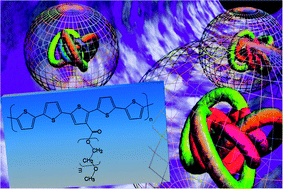Organic hybrid materials consisting of an all-conjugated polythiophene backbone and well-defined poly(ethylene glycol) (PEG) grafted chains have been prepared by anodic polymerization of chemically synthesized macromonomers. The latter consist of a pentathiophene sequence in which the central ring bears a PEG chain with Mw = 1000 or 2000 at the 3-position. The influence of the polymerization potential, the length of the PEG branches and the dopant agent on the structure and properties of the graft copolymers has been examined. The chemical structure of the grafted materials has been corroborated by FTIR and X-ray photoelectron spectroscopies. Scanning electron microscopy and atomic force microscopy studies reveal that the morphology and topography of these materials are influenced by the above mentioned factors, even though homogeneous films showing a compact distribution of nanoaggregates, very flat surfaces (i.e. roughness < 15 Å) and nanometric thickness (i.e. 100–500 nm) were obtained in all cases. Cyclic voltammetry assays have been used to determine the presence of charged species, the electroactivity, the electrostability and the formation of cross-links. The electrochemical stability of the copolymer with grafted PEG chains of Mw = 1000 has been found to increase with the number of consecutive oxidation–reduction cycles (self-electrostabilizing behavior). Finally, a preliminary investigation into the applicability of these hybrid materials as active surfaces for the selective adsorption of proteins is presented.

You have access to this article
 Please wait while we load your content...
Something went wrong. Try again?
Please wait while we load your content...
Something went wrong. Try again?


 Please wait while we load your content...
Please wait while we load your content...